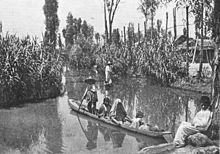Chinampa
Chinampas (Spanish-Aztec, formed from the Nahuatl word chinamitl = fence made of reeds) are artificial islands made of earth and organic materials . They were used as cultivation areas in shallow lakes in ancient Mexico and are sometimes incorrectly referred to as "floating islands" in the present day. Remains of this unusual agricultural system can still be seen in the region around Xochimilco .
Construction
The construction of a Chinampa was very complex: First, long wooden stakes were driven into the ground in the bank area of a lake. A floating wickerwork made of reeds was attached to these piles and filled with mud from the lake bed. This mud is very rich in nutrients and enabled up to four harvests per year. Then a border planting was created, for example with aquatic plants or willow bushes, which prevented with their roots that the mud was washed off the reed mats again. A complete chinampa could protrude up to 25 meters into the lake and often extend over 200 meters on the shore. Small huts were often built on top for the farmers.
Cultivation
The Chinampa system was born out of necessity in order to supply the sometimes very populous Aztec city-states, which had emerged on the central Mexican lakes, with food. Since the Aztecs, unlike their relatives in the highlands of Peru , did not know any pack animals, the food had to be produced mainly on site. A systematic expansion of highly productive cultivation areas was therefore essential. The Chinampas supplied the inhabitants in the high valley of Mexico City, for example, with corn , beans , tomatoes , guavas , avocados , sweet potatoes , chilies , but also with flowers.
The end of the Chinampas
The end of the Chinampa economy was determined by two main factors. For one thing, the Spanish conquerors very quickly introduced pack animals and new farming methods into Mexico. Food could now be transported from distant, high-yield growing areas over long distances. On the other hand, social changes contributed to the decline even before the arrival of the Europeans: the Aztecs had set up a trading system over longer distances despite the lack of pack animals and thus themselves contributed to the decline of the Chinampas. In addition, most of the lakes in the Mexican highlands have dried up over time and agriculture has been converted to irrigation systems with canals.
Web links
- Spencer Woodard, Chinampa: Raised-bed hydrological agriculture , April 24, 2011
